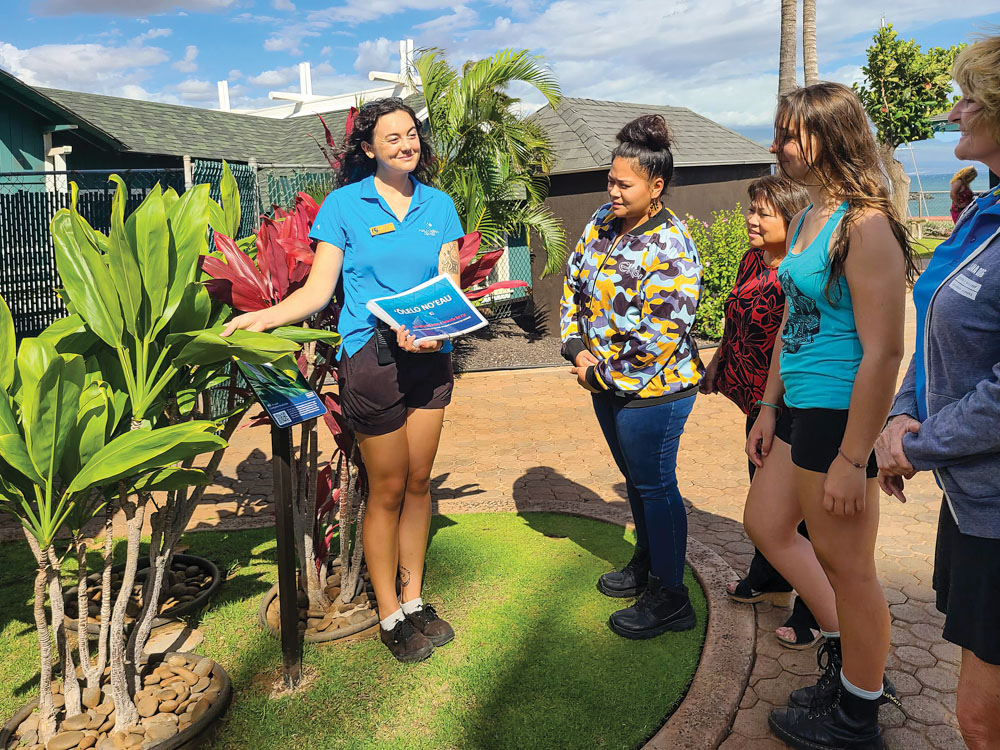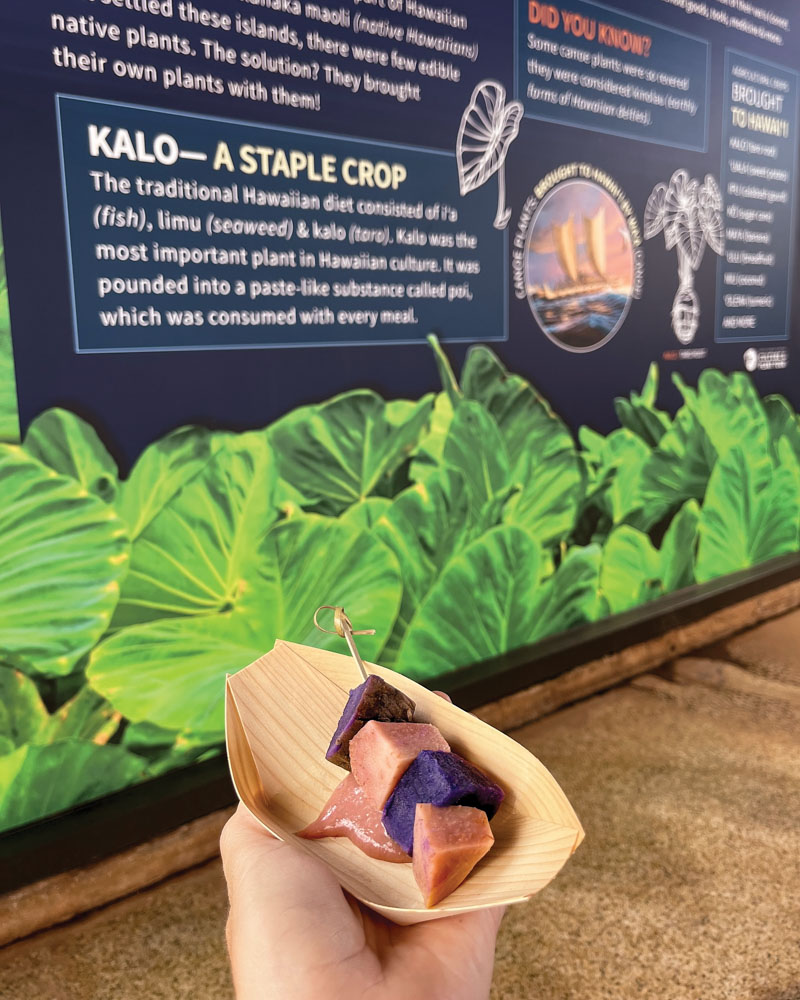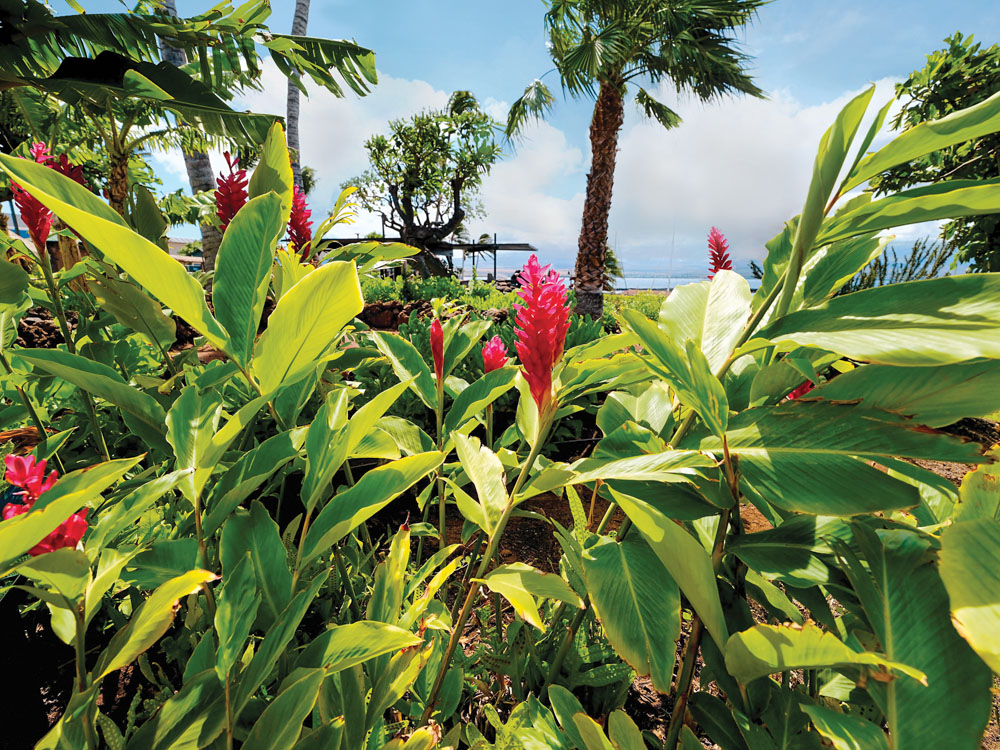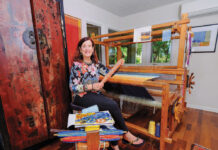Hawaiian Culture and Plant Tour
By Serene Gunnison

At the Maui Ocean Center, visitors might hardly notice the plants that line the aquarium’s outdoor walkways. After all, their heads are filled with visions of kaleidoscopic corals and apex ocean predators – and to the untrained eye, shrubs and vines and flowers are decidedly less exciting. But things are starting to change.
This summer, the Maui Ocean Center debuted a Hawaiian Culture and Plant Tour, illuminating the aquarium’s motley of native, endemic and canoe plants (plants brought to the islands by voyaging Polynesians). It’s a balmy Tuesday morning as a small group gathers near the aquarium entrance for the second-ever Hawaiian Culture and Plant Tour, led by Maui Ocean Center naturalists Sara and Kahiau. Sara is quick to answer the question on everyone’s mind: Why would an aquarium host a tour about plants?
“Anything that happens up in the mountains is going to affect what goes on in our waters,” Sara replied. “If you remove all of the plants from an area and it rains, all of that soil, all of those nutrients, fertilizers, runoff, that is going to hit the oceans and start to degrade our coral reefs.”
But it’s not just the ecological relationship between mauka (upland) and makai (sea) that this excursion aims to explore. In keeping with Maui Ocean Center’s commitment to honoring and showcasing Hawaiian culture, the 90-minute tour takes deep dives into plants’ role in Hawaiian life.
Hawaiians recognized the connection between plants and marine life. This parallel laid the foundation for many Hawaiian cultural pillars. As Sara leads the group to a small alahe‘e bush – a native shrub with glossy, deep green leaves and bunches of tiny fragrant white flowers – she recites a passage from the kumulipo, the Hawaiian creation chant.
“Hanau ka he‘e noho i kai. Kia‘i ia e ka alahe‘e noho i uka. Born is the octopus (or squid) living in the sea, guarded by the alahe‘e living on land.” Hawaiians believed that one species’ degradation would lead to its counterpart’s decline. “They’re considered the guardians of each other,” Sara said. “They cannot exist without one another.” This belief of interconnectedness also shaped Hawai‘i’s ancient ahupua‘a, or land division system, which divided parcels from the mountain tops to the sea. Sara passes around a Maui ahupua‘a map as guests try to pick out the ahupua‘a in which their home or hotel is located.

The excursion continues past vibrant orange ‘ilima flowers and woody tangles of hau bush. Sara sheds light on the many uses of each plant – whether medicinal, utilitarian or spiritual – and captures her audience with gripping legends starring the flora. “If you ever swim in freshwater [in Hawai‘i,] you have to watch out for someone known as the mo‘o wahine,” she says while the group gathers around a cluster of green ti plants.
The mo‘o wahine – which translates to lizard woman – is known to inhabit large pools of fresh water. “In order to check if she is home or not, you’re gonna take a leaf from the ti plant and float it right on top of the water. If it sinks, it means it’s not safe to swim. She’s home. She might drag you down with her. But if it floats, it means that it’s safe to swim that day.”
The tour moves into a shaded pavilion near the sea turtle exhibit. It’s time to learn about – and taste – the most vital Hawaiian plant of all: kalo. Also known as taro, kalo was once the main dietary staple in Hawai‘i and is believed to be the elder sibling of humanity.
As Sara passes around a platter of kalo, purple sweet potato and poi, Kahiau sits down before a lump of steamed kalo. Using a handmade papa ku‘i ‘ai (poi pounding board) and a pohaku ku‘i ‘ai (poi pounding stone), he begins to methodically beat the kalo until it turns into a gelatinous ball of poi. Kahiau makes the process look easy, but as the guests sit down for their turn, it becomes clear how much skill this practice takes.
After rinsing the starch from their fingers, guests filter off to explore the rest of the aquarium. The tour might be over, but the plant showcase continues at Seascape, the Maui Ocean Center’s onsite restaurant.
Seascape has long been a sustainability luminary in Maui’s restaurant industry, but now the restaurant is taking strides to craft inventive dishes using various canoe plants like ‘ulu and kalo. One such dish is the kalo poke nachos, which is made with diced and fried kalo, avocado salsa, kukui nuts and kalo chips. When available, the diced kalo is sourced from a small mala (dry taro patch) located mere feet from some of the restaurant’s outdoor tables.
While public awareness of Hawai‘i’s native, endemic and canoe plants have dwindled over time, it’s not unreasonable to think that these species could experience a cultural and culinary renaissance – especially when organizations like the Maui Ocean Center and the Seascape give them a platform. And perhaps this revival could lead to a renewed awareness of how our actions on land affect the ocean. After all, everything is connected – and the proof is in the plants.
The Hawaiian Culture and Plant Tour was developed in partnership with Maui Nui Botanical Gardens. A portion of each ticket sale goes to support MNBG. Tours are offered Tuesdays and Thursdays from 10:30 a.m. to 12 p.m. $34.95.

Click here to subscribe to Maui Nō Ka ‘Oi Magazine





